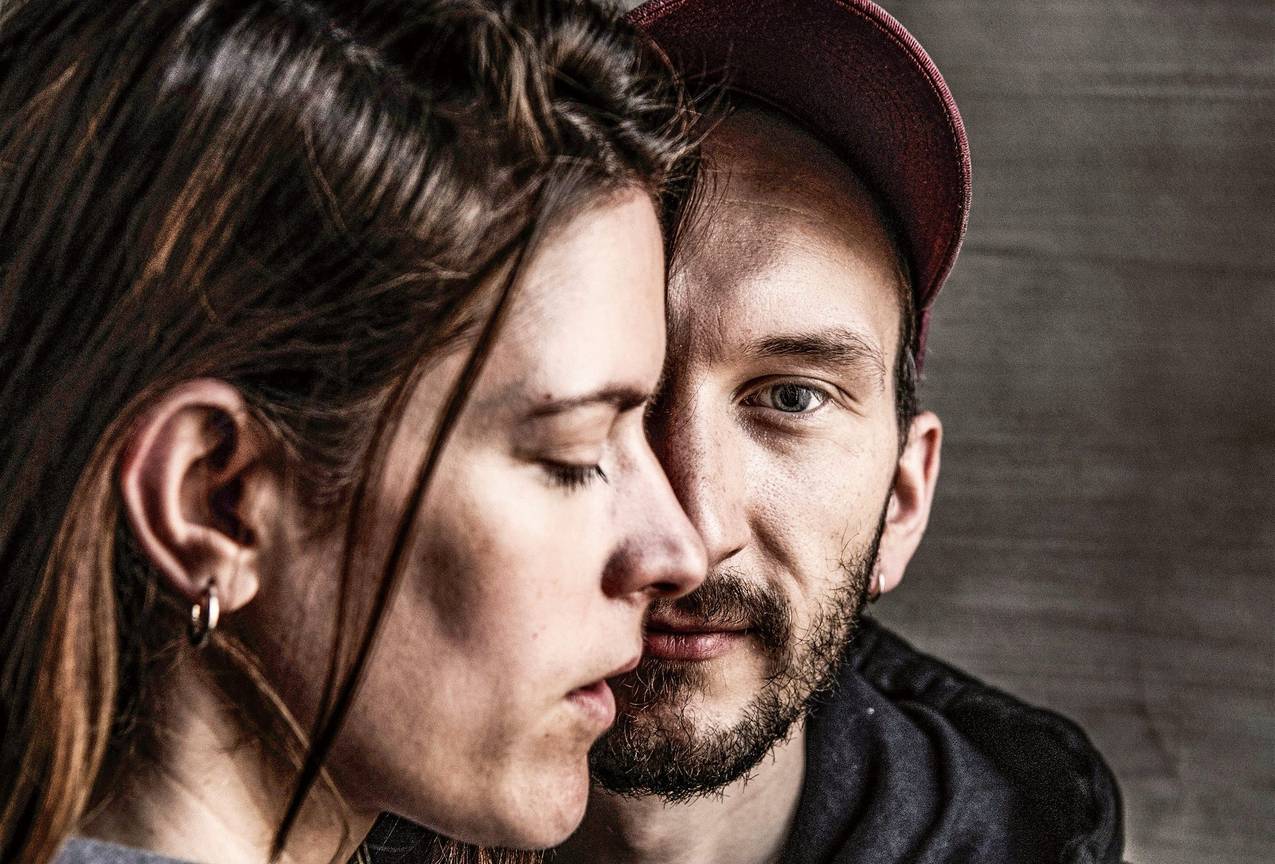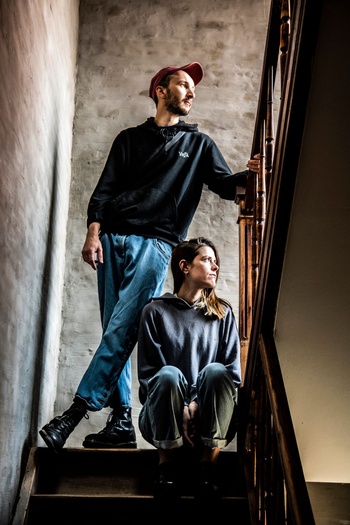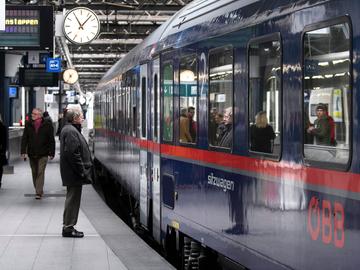As if the earth had not been picked bare enough, there are plans currently being made to harvest manganese tubers from the floor of the deep sea. Manganese-what? For all our questions about mining on land and at sea, we can turn to theatre-makers Silke Huysmans and Hannes Dereere.

© Saskia Vanderstichele
Silke Huysmans & Hannes Dereere dive to the bottom of Kunstenfestivaldesarts
Silke Huysmans underwent her theatre training at the KASK in Ghent and Hannes Dereere did theatre studies at the University of Ghent. His electives brought him into contact with her and his academic, research-oriented background was a match for her art education. During their first small location projects, they conducted lengthy research into places with a specific story. At first this, all this produced was a text but then at some point an interview from the research turned into a performance.
In the trilogy that they have been making together since 2016, research into a particular location and people's testimonies are fixed components that are then given artistic form. The trilogy, which they created at the art centre CAMPO and showed at the Beursschouwburg, consists of Mining Stories, Pleasant Island and now Out of the Blue, which will premiere at the Kunstenfestivaldesarts. It revolves around subjects such as ecology, social and political systems, communication, power relations, visual culture, science and morality but this universal theme always departs from a concrete, international issue that has to do with... mining.
Because of this very “earthly” theme, and because of the thorough research that precedes your pieces, your work is sometimes called documentary or journalistic theatre.
Silke Huysmans: That is not how we see it ourselves. We always give the audience the necessary information about the subject of our research, and we also put a lot of love and time into that research. But the most important thing is to translate the “dry material” artistically and that is where most of the work is done. What we do is not investigative journalism, but theatre pieces with their own story and specific form. We also show our methods and our editing, our interpretation and our feelings on stage.
You draw on mining universal stories which are captivating too because you repeatedly find interesting international cases that receive comparatively little media attention.
Huysmans: Mining is indeed not an obvious subject for theatre. It is perhaps a bit more obvious in the visual arts because you work with raw materials more concretely. But everything that surrounds us is raw material that comes from somewhere, and it is interesting to find out how it ends up here. The world never finds out about so many stories like these. The mining disaster that inspired Mining Stories took place in the region where I grew up (Huysmans lived with her parents in Brazil for the first eight years of her life, ed.). The fact that it was not in the news much was certainly one of the triggers for investigating it, as it was one of the greatest mining disasters in the world. Pleasant Island was about the small Pacific island of Nauru, where phosphate was mined in the past and refugee camps have recently been set up. It is also a story that was deliberately kept out of the media and that you can make visible and discuss in the theatre. At the end of Pleasant Island, we also talked about the plans for deep sea mining in that region. That is now the starting point for Out of the Blue.
What is deep sea mining?
Hannes Dereere: This is an industry that does not actually exist yet because scientific studies are still being done on its impact on the deep-sea ecosystem. In fact, we have only discovered 10% of the seabed, while it makes up 80% of the earth's surface. It also requires technology to mine at depths of 4,500 metres. There are various methods of deep-sea mining that are now being considered and one of the methods being tested, pending a legislative framework, is the mining of manganese nodules on the seabed.
One of the more technical stories that is not in the show is the one about the Clarion-Clipperton Zone (CCZ) is a five million square kilometre stretch of ocean between Mexico and Hawaii, established by the International Seabed Authority (ISA), where countries and companies are allowed to conduct deep-sea mining research according to a set of rules. For example, the large Belgian dredging company DEME now operates there with its new branch Global Sea Mineral Resources (GSR), with Belgium as its regulator.
In that large zone in the Pacific Ocean, millions of years old, small, black “manganese tubers” (estimated at 21 billion tonnes) are full of metals such as nickel, copper, manganese and cobalt at a depth of 4,500 metres. Those manganese tubers alone account for more metals than can be found on the surface of the earth. As a result, they could be used for the production of batteries, solar panels and electric cars that we need for the energy transition. You can suck up those manganese tubers with a robot, but that disturbs the soil and creates a dust cloud just above it that lingers for a very long time and eventually lands as a layer of ash. The tubers are also home to organisms that need this bonding. We do not yet know how important these organisms are, but we do know that they will not return if the tubers disappear. The discussion then is whether we should sacrifice that part of our exhausted planet too, sucking up those million-year-old tubers in a matter of seconds on the grounds that they are necessary for the energy transition.
Belgium apparently plays an important role in this new type of mining.
Dereere: In this industry, all eyes are on Belgium because DEME-GSR has the best mining robot to date. We have known for some time that an expedition would take place in the spring of 2021 to lower a prototype mining robot 4,500 metres down to the seabed for the first time in history. At the same time, there was a scientific ship present to study the impact of that expedition. On top of that, unexpectedly for us too, Greenpeace's Rainbow Warrior came to that otherwise totally deserted spot in the ocean, where normally not even planes fly over.
Those three ships can stand for industry, science and activism and we thought it would be interesting to contact them from our flat. To listen to the debate. Greenpeace does not want us to exploit that remaining virgin place. The industry is using the argument of energy transition. The scientists are in the middle: on the one hand, the interest of the industry gives them a unique opportunity to do deep-sea research, on the other hand, what they explore for the first time also threatens to disappear immediately.
There is something unreal about being in contact with those three ships on the other side of the world from a flat in Brussels.
Huysmans: We emailed the coordinator of the research boat in advance to ask if we could follow the expedition, and our experience in the past is that academics often respond quickly. Belgian marine biologist Jolien Goossens from Ghent University was on board and coordinated the interviews on site. We were able to convince Greenpeace after a personal Zoom meeting when they were already on site campaigning. We spoke to the CEO of DEME-GSR too, who set aside more than two hours for us. But we won't go over all that in the show. We select mainly fragments from the interviews that offer a broader reflection on the issue. It was also interesting what the three parties had to say about each other. If we had been on the spot on one of the ships, we would probably have had less understanding over the whole expedition than by observing them from a distance.
'We know more about the surface of the moon than we do about our own oceans, and yet technology takes us where we have never been before'

© Saskia Vanderstichele
'Greenpeace does not want us to exploit that remaining virgin place. The industry is using the argument of energy transition. The scientists are in the middle'
You also always provide a clever design that relates to the content. Can you say anything about that?
Huysmans: Apart from the distance between us and the ships, the distance between the ships and the seabed is also fascinating. Scientists describe this exploration with underwater cameras that shine their light on the bottom as a trip through a mountain landscape in the dark with the headlights of your car. What you don't see is anything that the light scares away. The difference is that the scientists are not in the car themselves: the researchers control the robot from a room full of screens on the ship, and sometimes forget that there is still four kilometres of water below them. That small room from which you study something that is infinitely large was something we found it interesting to theatricalise. Because it also represents our distance from the immense subject.
Try to put that immensity into words.
Huysmans: Deep-sea mining is a challenging subject to begin with, because it does not yet exist and we have no idea what its scope is and who the protagonists will be. The deep sea belongs to us all: it is humankind's common heritage that makes us think about the world and the future. Do we still want this form of exploitation or not? What do scientists think today, themselves confronted with a thousand new questions with every new discovery? Do we still listen to scientific facts? During our research, the scientists in the film Don't look Up also sprung to mind. Companies use scientific facts to their advantage. Greenpeace uses their facts to do storytelling. Scientists help to make visible something that could also have remained hidden. Is it sometimes better not to know something?
At the same time, it is funny that we know more about the surface of the moon than we do about our own oceans, and yet technology takes us where we have never been before: into the deep sea where life originated, and where we do not know what it still has to offer us.
It was a very challenging project that ultimately is also about Hannes and me. We try to make our interpretations and feelings tangible. The title Out of the Blue refers to the resources that could be extracted from the blue ocean right now. But “Blue” also refers to a feeling that came over us during the making. We know that the world is not doing so well. We are overwhelmed by bad news. Deep-sea mining is yet another way to further exploit the world and at the same time is presented as a way to get “out of the blue”.
SILKE HUYSMANS & HANNES DEREERE: OUT OF THE BLUE
19>25/5, Beursschouwburg, www.kfda.be
Read more about: Podium , Kunstenfestivaldesarts , Beursschouwburg , DEME , Silke Huysmans , Silke Huysmans & Hannes Dereere , Greenpeace



